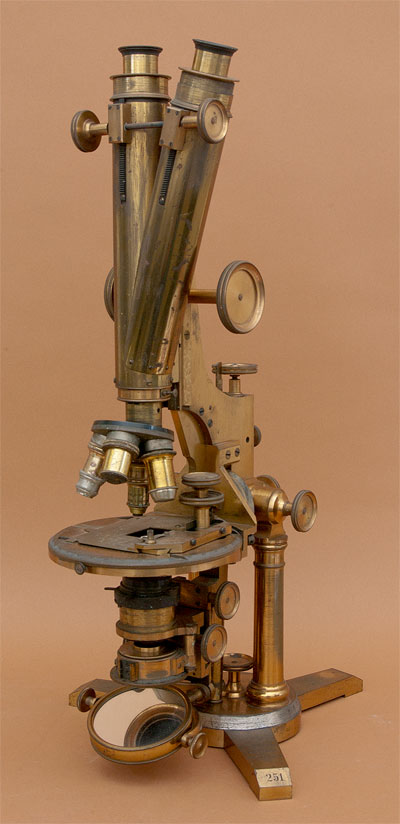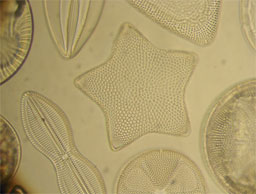 |
|||||
 |
 |
||||
 |
|||||
 |
 |
||||
W. H. Bulloch Compound Microscope (No. 160) |
|||||||||||
 |
Age: 1881 Made by: W. H. Bulloch Made in: Chicago, United States |
||||||||||
 |
|||||||||||
|
W.H. Bulloch
|
|||||||||||
 |
|||||||||||
|
Diatoms imaged using the 1/4" Watson & Sons objective
|
|||||||||||
|
The firm of Walter. H. Bulloch of Chicago began in 1866 and continued until Walter died in 1891. W.H. Bulloch was one of 20 American microscope manufacturers in the 1880s. Spencer was the earliest, starting in 1840. By the turn of the century, only two American companies remained: Bausch & Lomb and The Spencer Lens Company. Bulloch microscopes were highly regarded in their day, and their high level of craftsmanship is apparent in this specimen. This microscope is one of Bulloch's "Congress Binocular Microscopes" introduced in 1881. This Bulloch "A1 Congress" microscope sold for $300 in 1879. This is a large and heavy instrument (21 pounds) with a flat tripod base supporting two tubular pillars. It was designed to be used in either the upright or horizontal position. The substage Abbe-type condenser and illuminating mirror are mounted on articulating arms. Each pivots independently, allowing the condenser to rotate out of the light path (for oblique illumination), and the mirror to rotate completely around to illuminate the sample from above. The microscope body pivots on its center of gravity for horizontal viewing, and a rotating mount in the base allows the operator to rotate the entire microscope without moving the tripod base. The revolving nose-piece has four objective positions. There are four objectives with this instrument, ranging from 1-1/2 inch (low magnification) to an oil immersion 1/12 inch (high magnification) lens. This microscope has both coarse and fine focus and a variable tube length. There are two Kellner eyepieces. There is a slot in the side of the straight downtube that held the Wenham binocular prism. This is a polarized light microscope as it has a graduated rotating stage and positions for the polarizer (below the condenser) and analyzer (above the objectives). Both polars and the Wenham prism are now missing. This microscope has very fine optics. They exhibit little to no chromatic or spherical aberration. |
|||||||||||
| Microscope featured 4/05; 11/16 | |||||||||||